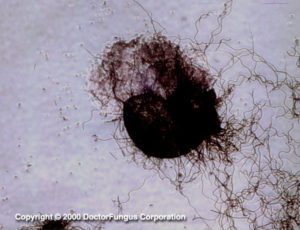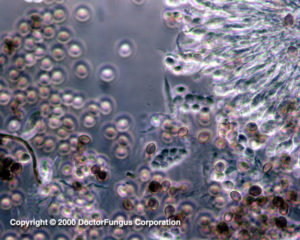(described by Kunze in 1817)
Taxonomic classification
Kingdom: Fungi
Phylum: Ascomycota
Class: Euascomycetes
Order: Sordariales
Family: Chaetomiaceae
Genus: Chaetomium
Description and Natural Habitats
Chaetomium is a dematiaceous filamentous fungus found in soil, air, and plant debris. As well as being a contaminant, Chaetomium spp. are also encountered as causative agents of infections in humans. Some species are thermophilic and neurotropic in nature [1295, 2202].
Species
The genus Chaetomium contains several species. The most common ones are Chaetomium atrobrunneum, Chaetomium funicola, Chaetomium globosum, and Chaetomium strumarium.
Synonyms
See the summary of synonyms for the Chaetomium spp.
Pathogenicity and Clinical Significance
Chaetomium spp. are among the fungi causing infections wholly referred to as phaeohyphomycosis. Fatal deep mycoses due to Chaetomium atrobrunneum have been reported in an immunocompromised host. Brain abscess, peritonitis, cutaneous lesions, and onychomycosis may also develop due to Chaetomium spp. [531, 776, 940, 1937, 2202].
Macroscopic Features
Chaetomium colonies are rapidly growing, cottony and white in color initially. Mature colonies become grey to olive in color. From the reverse, the color is tan to red or brown to black [531, 1295].
Microscopic Features
Septate hyphae, perithecia, asci and ascospores are visualized. Perithecia are large, dark brown to black in color, fragile, globose to flask shaped and have filamentous, hair-like, brown to black appendages (setae) on their surface. Perithecia have ostioles (small rounded openings) and contain asci and ascospores inside. Asci are clavate to cylindrical in shape and rapidly dissolve to release their ascospores (4 to 8 in number). Ascospores are one-celled, olive brown in color, and lemon shaped [531, 1295].
Laboratory Precautions
No special precautions other than general laboratory precautions are required.
Susceptibility
Very few data are available and there is as yet no standard method for in vitro susceptibility testing of Chaetomium spp. While MICs of amphotericin B, ketoconazole, itraconazole, and miconazole were acceptably low, those of fluconazole and flucytosine appeared very high when a small number of Chaetomium atrobrunneum, Chaetomium funicola, and Chaetomium globosum isolates were tested [920, 1855]




